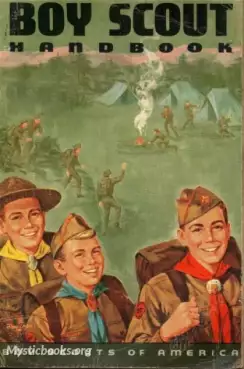Boy Scouts of America
The Boy Scouts of America (BSA, colloquially the Boy Scouts) is one of the largest scouting organizations and one of the largest youth organizations in the United States, with about 1.2 million youth participants. The BSA was founded in 1910, and since then, about 110 million Americans have participated in BSA programs. BSA is part of the international Scout Movement and became a founding member organization of the World Organization of the Scout Movement in 1922.
The stated mission of the Boy Scouts of America is to "prepare young people to make ethical and moral choices over their lifetimes by instilling in them the values of the Scout Oath and Law." Youth are trained in responsible citizenship, character development, and self-reliance through participation in a wide range of outdoor activities, educational programs, and, at older age levels, career-oriented programs in partnership with community organizations. For younger members, the Scout method is part of the program to instill typical Scouting values such as trustworthiness, good citizenship, and outdoors skills, through a variety of activities such as camping, aquatics, and hiking. To further these outdoor activities, the BSA has four high-adventure bases: Northern Tier (Minnesota, Manitoba, and Ontario), Philmont Scout Ranch (New Mexico), Sea Base (Florida, US Virgin Islands, and Bahamas), and Summit Bechtel Reserve (West Virginia), as well as nearly one hundred separate camps and reservations specifically dedicated to scouts.
The original Scouting divisions are Cub Scouting for ages 5 to 11 years, Scouts BSA for ages 10 to 18, Venturing for ages 14 through 21, and Sea Scouts for ages 14 through 21. The BSA operates Scouting by chartering local organizations, such as churches, clubs, civic associations, or educational organization, to implement the Scouting program for youth within their communities. Units are led entirely by volunteers appointed by the chartering organization, who are supported by local councils using both paid professional Scouters and volunteers. Additionally, Learning for Life is an affiliate that provides in-school and career education.
On February 1, 2019, the Boy Scouts of America renamed its flagship program, Boy Scouts, to Scouts BSA to reflect its policy change allowing girls to join separate, gender-specific troops. Shortly thereafter, the largest charter organization supporting BSA, The Church of Jesus Christ of Latter-day Saints, decided to part ways substantially contributing to a net loss of nearly a million scouts/leaders. On February 18, 2020, the National BSA filed for Chapter 11 bankruptcy protection and is currently restructuring its financial situation. On November 16, 2020, the National BSA disclosed in their bankruptcy filings that over 92,000 former Scouts had reported sexual abuse by members of the organization. In December of 2021, the insurer for the Boy Scouts of America agreed to pay $800M into the fund for victims.
The progressive movement in the United States was at its height during the early 20th century. With the migration of families from farms to cities, there were concerns among some people that young men were no longer learning patriotism, self-reliance, and individualism. Several groups attempted to fill this void. The YMCA was an early promoter of reforms for young men with a focus on social welfare and programs of mental, physical, social and religious development. Others, included the Woodcraft Indians started by Ernest Thompson Seton in 1902 in Cos Cob, Connecticut, and the Sons of Daniel Boone founded by Daniel Carter Beard in 1905 in Cincinnati, Ohio., two notable independent scouting predecessors of BSA within the United States.
In 1907, Robert Baden-Powell founded the Scouting movement in England using elements of Seton's works among other influences. In 1909, Chicago publisher W. D. Boyce was visiting London, where he encountered a boy who came to be known as the Unknown Scout. Boyce was lost on a foggy street when an unknown Scout came to his aid, guiding him to his destination. The boy then refused Boyce's tip, explaining that he was a Boy Scout and was merely doing his daily good turn. Interested in the Boy Scouts, Boyce met with staff at the Boy Scouts Headquarters and, by some accounts, Baden-Powell. Upon his return to the US, Boyce was inspired by his experience and incorporated the Boy Scouts of America on February 8, 1910. Edgar M. Robinson and Lee F. Hanmer became interested in the nascent BSA and convinced Boyce to turn the program over to the YMCA for development in April 1910. Robinson enlisted Seton, Beard, Charles Eastman, and other prominent leaders in the early youth movements. Former president Theodore Roosevelt, who had long complained of the decline in American manhood, became an ardent supporter. In January 1911, Robinson turned the movement over to James E. West who became the first Chief Scout Executive and Scouting began to expand in the US Among other programs in the US, the Woodcraft Indians and Sons of Daniel Boone, eventually merged with the BSA.
The BSA's stated purpose at its incorporation in 1910 was "to teach [boys] patriotism, courage, self-reliance, and kindred values." Later, in 1937, Deputy Chief Scout Executive George J. Fisher expressed the BSA's mission: "Each generation as it comes to maturity has no more important duty than that of teaching high ideals and proper behavior to the generation which follows." The current mission statement of the BSA is "to prepare young people to make ethical and moral choices over their lifetimes by instilling in them the values of the Scout Oath and Law."
At its peak, Boy Scouts had an active membership of over 4 million youth in 1973. Today, popularity in outdoor events has waned and membership has dropped. However, BSA remains the largest scouting organization and one of the largest youth organizations in the United States, with about 1.2 million youth participants and about one million adult volunteers as of 2021.
Books by Boy Scouts of America

Boy Scouts Handbook
This book is an essential guide toward understanding wilderness survival as well as pre-military training and life training in general.
